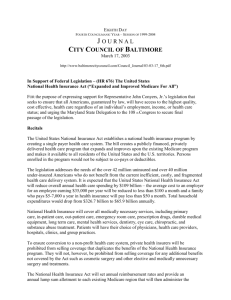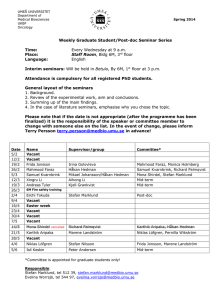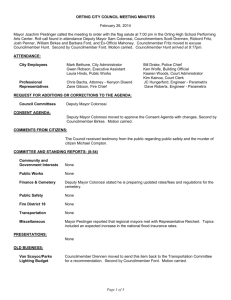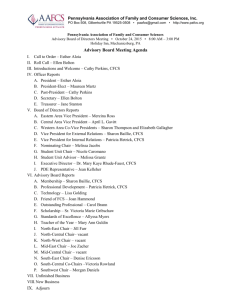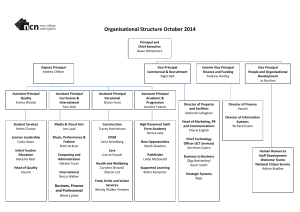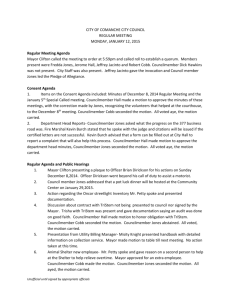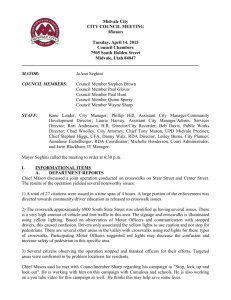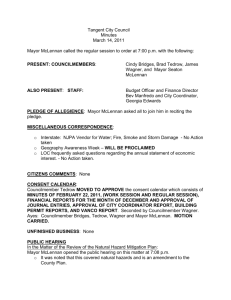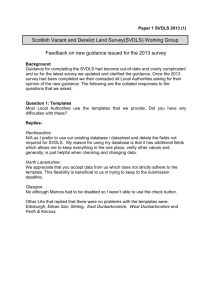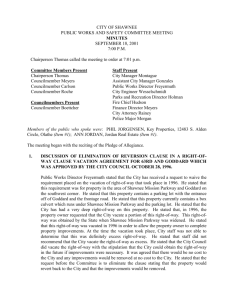Housing Report - City of St. Petersburg
advertisement
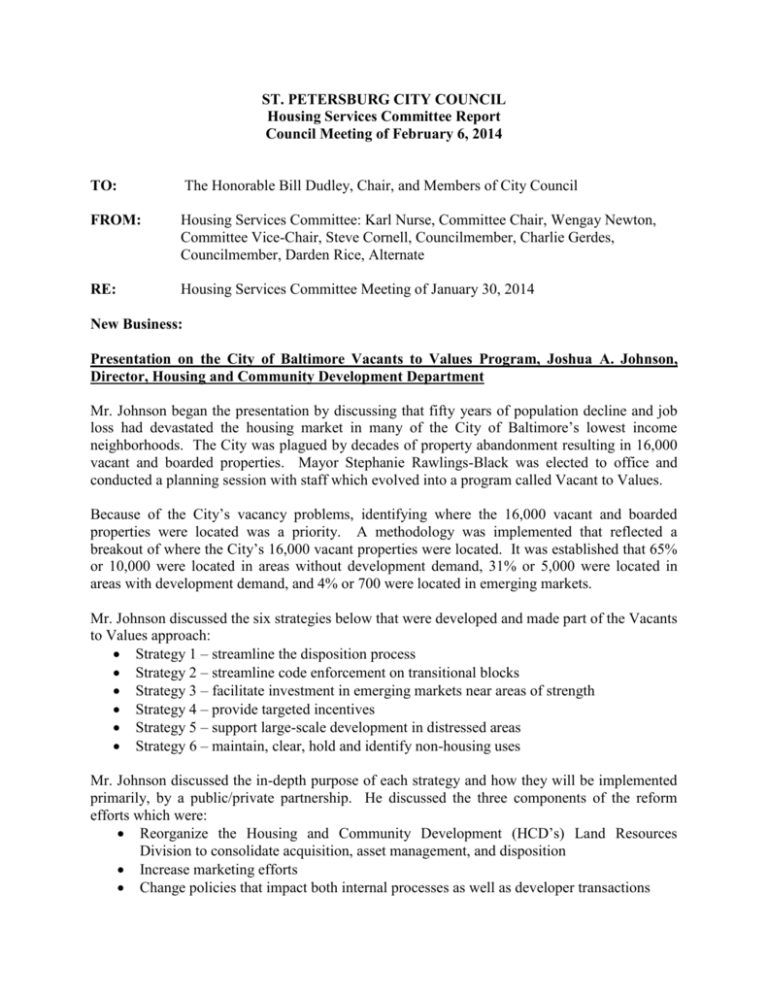
ST. PETERSBURG CITY COUNCIL Housing Services Committee Report Council Meeting of February 6, 2014 TO: The Honorable Bill Dudley, Chair, and Members of City Council FROM: Housing Services Committee: Karl Nurse, Committee Chair, Wengay Newton, Committee Vice-Chair, Steve Cornell, Councilmember, Charlie Gerdes, Councilmember, Darden Rice, Alternate RE: Housing Services Committee Meeting of January 30, 2014 New Business: Presentation on the City of Baltimore Vacants to Values Program, Joshua A. Johnson, Director, Housing and Community Development Department Mr. Johnson began the presentation by discussing that fifty years of population decline and job loss had devastated the housing market in many of the City of Baltimore’s lowest income neighborhoods. The City was plagued by decades of property abandonment resulting in 16,000 vacant and boarded properties. Mayor Stephanie Rawlings-Black was elected to office and conducted a planning session with staff which evolved into a program called Vacant to Values. Because of the City’s vacancy problems, identifying where the 16,000 vacant and boarded properties were located was a priority. A methodology was implemented that reflected a breakout of where the City’s 16,000 vacant properties were located. It was established that 65% or 10,000 were located in areas without development demand, 31% or 5,000 were located in areas with development demand, and 4% or 700 were located in emerging markets. Mr. Johnson discussed the six strategies below that were developed and made part of the Vacants to Values approach: Strategy 1 – streamline the disposition process Strategy 2 – streamline code enforcement on transitional blocks Strategy 3 – facilitate investment in emerging markets near areas of strength Strategy 4 – provide targeted incentives Strategy 5 – support large-scale development in distressed areas Strategy 6 – maintain, clear, hold and identify non-housing uses Mr. Johnson discussed the in-depth purpose of each strategy and how they will be implemented primarily, by a public/private partnership. He discussed the three components of the reform efforts which were: Reorganize the Housing and Community Development (HCD’s) Land Resources Division to consolidate acquisition, asset management, and disposition Increase marketing efforts Change policies that impact both internal processes as well as developer transactions Housing Services Committee Report January 30, 2014 Page 2 The presentation documented that buying City-owned properties should be: Clear o Must include a searchable inventory o User friendly on-line application Predictable o Set pricing with reserve bid o Reduced transaction time reduces financial risk Transparent o City must have web-based marketing tool o Provide public notice of properties for which offers are received The presentation discussed Lien Abatement, its problems and solution, Inventory Marketing, its problem and solutions, Pricing Policy Amendment and its problems and solutions. Other issues discussed included holding auctions and selling City owned properties at auction, and prequalifying bidders to assure their financial capacity and rehabilitation ability. The presentation included discussion of Transitional Blocks with Scattered Vacants which found the following: The private market is generally healthy enough to support the rehabilitation of vacant property. Typically only minimal code enforcement efforts are required to prompt rehabilitations. Targeting Scattered Abandonment o On transitional blocks where housing markets are otherwise healthy, boarded structures are limited to only a few per block. In these areas, effective code enforcement can successfully leverage rehabilitation. o The goal during the first year code enforcement will use new, streamlined processes to target 1,000 vacant buildings on transitional blocks ultimately triggering their rehabilitation and the overall strengthening of these neighborhoods. Emerging Markets – are characterized by high concentration of abandoned properties, many of which are owned by the City or are in tax arrears. Because of their potential, private developers are interested in rehabilitating some of these blocks but require the City’s assistance to ensure that their efforts are not undermined by other vacant properties. Emerging Markets – consists of Public-Private Partnerships where the private sector is counted on to take the lead with some City incentives. Emerging Markets – need for Coordinated City Investment and Services o Ensure adequate street lighting and facilitate the paving of streets, repair of sidewalks and the attraction of new commercial amenities on reclaimed blocks o Allocate additional capital dollars for demolition to eliminate those vacants that impede additional investments o Assign resources from City agencies Police Streetscaping/Lighting Housing Services Committee Report January 30, 2014 Page 3 Planning The City supported Large Scale Redevelopment o Many distressed areas with concentrated abandonment do not have private development potential and so large scale development initiatives are needed. Maintenance, Clearance, Land Banking and Non-Housing Uses o Demolition, land banking, regular cleaning and securing of the inventory, as well as the active promotion of creative non-housing uses are essential to creating value in the long term. o The housing market will generally not support the rehabilitation of these vacant properties and many of these blocks will need to be demolished. Much of the land needs to be banked and open-space and non-housing uses promoted at least temporarily. Mr. Johnson discussed the expected outcomes and goals of each of the six strategies. Comments made after the presentation included: Chair Nurse who said we have huge number of unbuildable lots in the City which are a burden to the City, and doing something with them will be useful. Councilmember Kornell questioned the appraisal process and discussed that he would like to see a program where current owners of housing who have the ability to purchase additional properties are able to do so to rent them out because since they are invested in the community and will care more than absent landlords. Mike Dove, Neighborhood Services Administrator discussed that he has been following the vacant to values program since it started. We have 800 plus vacant and boarded properties in the City; and housing and code enforcement is used to address the problem in Baltimore. He wants to tour all of the areas of the City; it is actually different when you actually look at the neighborhood as opposed to the map. He would like to come back in two months with more details. He also discussed that he has meetings schedules four private developers and that the private sector has to be brought to the table as the City needs support. Finally, Mr. Dove discussed that this is how the Old Northeast and Kenwood were turned around. Councilmember Rice discussed that this is exciting and enlightening. She further discussed Baltimore’s accomplishments during the past few years. Vice Chair Newton discussed the problem of people parking on yards and driving over curbs which results in broken sidewalks, and curbs. Alley’s that are in poor condition is also a problem. The City can control the infrastructure and he strongly urged the Committee to look at making improvements to the infrastructure. Councilmember Kornell discussed that he believes the St. Petersburg Housing Authority has the ability to provide assistance to its tenants who would like to purchase a home. Action: No action taken. Housing Services Committee Report January 30, 2014 Page 4 Update of NSP-1 & NSP-3, Stephanie Lampe, Sr. Housing Development Coordinator Ms. Lampe provided the status of the Neighborhood Stabilization Programs 1 and 3. Twelve (12) houses are completed, four (4) houses have been purchased and renovated; contracts are on two (2) properties for sale from NSP 1. She also discussed that as of today, the City has expended 80% of NSP 3 and are on schedule to expend 100 percent of the funding allocation on or about the deadline established by the U.S. Department of Housing and Urban Development (HUD) on March 10, 2014. Vice Chair Newton questioned what is the status of program income. Ms. Lampe responded that we will be using program income as we pull other parcels out of the land bank to construct new units, after which it will continue to be recycled. Mr. Johnson discussed that Governor Scott submitted his budget to the Legislature on Wednesday, and that in the budget, only $20 million was recommended for the State Housing Initiatives Partnership (SHIP) Program. Florida Housing informed all local governments that the Governor recommends $89.3 million of housing funding ($69.3 million for the SAIL Program and $20 million for the SHIP Program). This represents a recommended appropriation of only 30% of available funding. The Governor recommends sweeping $142.3 million from SHIP to General Revenue. This is 49% of available funding. The other $61.73 million is left in limbo and now reflected anywhere in the budget. Reports from various new agencies reflect that the Governor has swept housing trust funds to the general fund to allocate funding to newly created Florida’s Land and Legacy Program. The Committee was informed that Administration has been asked to advocate on behalf of funding SHIP at its full allocation collected from Documentary Stamps collected. Action: No action taken. Next meeting: To be held February 27, 2014. Topics: Update of the NSP-1 and NSP-3 Programs Additional topics to be determined Committee Members Karl Nurse, Chair Wengay Newton, Vice-Chair Steve Kornell, Councilmember Charlie Gerdes, Councilmember Darden Rice, Councilmember (Alternate)
